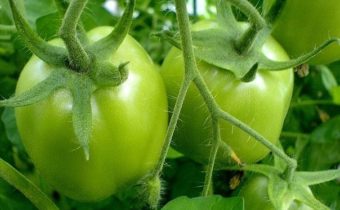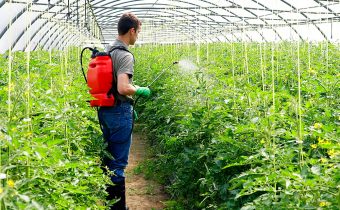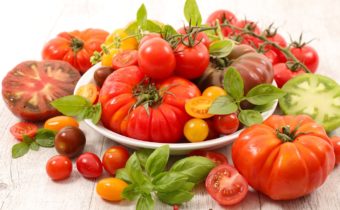Tomato "Pink elephant": large-fruited with numerous advantages
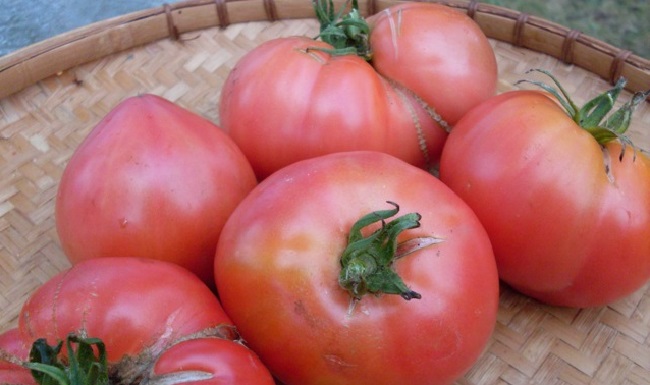
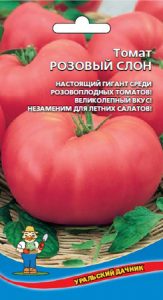 One of these wonderful varieties is the Pink Elephant Tomato, a colorful description of the variety and a photo completely coincide with the reviews of those who like these delicious tomatoes. The variety is medium early, with a maturity of 110-115 days after germination. The plant is considered semi-determinant, as it can grow up to 2 m or more in greenhouses.
One of these wonderful varieties is the Pink Elephant Tomato, a colorful description of the variety and a photo completely coincide with the reviews of those who like these delicious tomatoes. The variety is medium early, with a maturity of 110-115 days after germination. The plant is considered semi-determinant, as it can grow up to 2 m or more in greenhouses.
The “pink elephant” is mostly grown in summer cottages in greenhouses or in the ground under temporary shelters, as the branches loaded with large fruits require obligatory garters and are inconvenient for growing in large farms.
The main thing about the variety
The bush at the variety “Pink Elephant” is a powerful, medium leafy, formed mainly in two stems. The leaves are large, similar to the potato. Ovaries begin to appear after the 7th leaf. Tomatoes grow with brushes.
Fruit Description
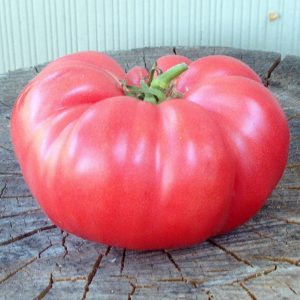
- The fruits are bright pink.
- The shape of the tomatoes is round, slightly flattened.
- In one hand up to 4 fruits.
- The weight of tomatoes on the first racemes reaches 500g (in some cases up to 800g), on subsequent ones it is generally less - 200-300g.
- The pulp of tomatoes is sweet, juicy, "sugary" at the break.
- Variety mainly salad destination, is also used for the preparation of tomato paste, ketchup, juice.
- Productivity - 7-8 kg from 1 sq.m.
Pests and diseases
Tomato pink elephant, according to its characteristics and description, refers to varieties that are resistant to diseases. However, the fact that it ripens at a later time as compared with many tomatoes makes it susceptible to phytophthora and some other diseases.
The use of greenhouse makes the growing conditions for tomatoes more comfortable, but it also increases the risk of bacterial and fungal infections. To prevent plants from getting sick, it is recommended:
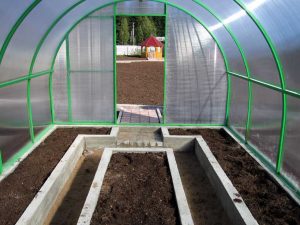
- Conduct disinfecting treatment of the greenhouse, inventory, soil.
- Treat seeds and soil for seedlings.
- In the process of vegetation of plants they are treated with copper-containing preparations before the formation of fruits.
- When the first signs of infection appear, the tomatoes are pulled out and burned. The remaining plants are treated with phytosporin and Bordeaux mixture.
Ground insects are easier to detect - you only need to carefully examine the foliage and stem of plants. To combat them use various deterrent compounds - infusions of garlic, onions, and wormwood. Colorado beetles are harvested by hand, and it is advisable not to miss the moment of appearance of the larvae, which is always more difficult to handle.
See also: The best varieties of tomatoes for open ground
It is much more difficult to detect pests living under the ground. To control them, before planting, it is necessary to deeply dig up the soil, to collect and destroy pests. In case of massive damage to plants by pests, entericidal preparations are used.
Advantages and disadvantages
The numerous advantages that pink elephant tomatoes have for reviews echo the fruit photo.
The advantages of the variety:
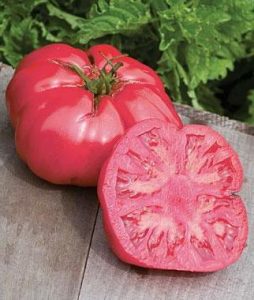
- Attractive appearance of pink fruits that grow tassels.
- Large fruit - maximum weight reaches 800g.
- Fine taste of fleshy juicy fruits.
- Resistance to diseases.
- High yield.
- Tomatoes are well stored and transported.
The drawbacks noted are the need to form and tie the stems to the support. Despite the fact that the bushes of tomato Pink Elephant are powerful, the gravity of the fruit requires garters to trellis.
Some gardeners note the presence of cracking of fruits in the area of the stem. However, this defect can be explained by weather conditions or excessive watering of plants.
Features of plant care
Usually seedlings are planted at the age of 55-60 days. Based on these terms, each vegetable grower determines the time of the start of planting.
Seed preparation
Since the Pink Elephant variety has long since settled in the dacha plots, many summer residents have their own seeds, or they are obtained from their colleagues, gardeners. If you buy seeds, you need to check the date of issue, expiration date and manufacturer.
To protect tomatoes from infection, seeds are sown before sowing:
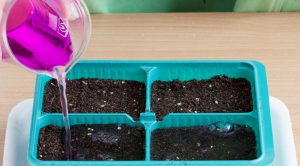
- In a solution of potassium permanganate (1%) or phytosporine for 20 min.
- Washed in water.
- Treated with growth promoters or a solution of trace elements for 5-6 hours.
Soil for growing seedlings, you can buy ready-made in the store or cook yourself. To do this, mix the decontaminated garden soil with peat, compost and ash. If the garden soil is clay, add peat or sand to it.
See also: Tomato "Slav". Variety description
Seedling care
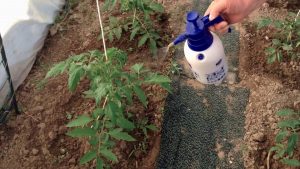 Treated seeds are sown in wet ground at intervals of 2–3 cm, covered with earth (5–7 mm) and covered with thick paper or film. To speed up seedlings, tare with seedlings is placed for germination at a temperature of 24-25 degrees.
Treated seeds are sown in wet ground at intervals of 2–3 cm, covered with earth (5–7 mm) and covered with thick paper or film. To speed up seedlings, tare with seedlings is placed for germination at a temperature of 24-25 degrees.
After 4-6 days, depending on the temperature, loops - sprouts of tomatoes appear on the surface of the ground in the boxes. After this, your task is to provide maximum illumination. If there are cloudy days, be sure to add artificial lighting so that the seedlings do not stretch out.
To increase the stability of seedlings, you can spend a two-week hardening of plants, for this temperature is reduced during the day to 15-16 degrees., At night to 12-14 degrees. Watering the whole of this period is carried out very carefully, not allowing the soil to dry out.
Pickling seedlings
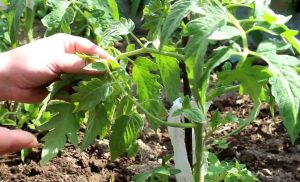 Seedlings dive into separate containers or larger boxes, when the plants will have 3-4 true leaves. At the same time the distance between them is increased to 15-20cm. Watering the seedlings as the soil dries out, for the entire period 1-2 feedings are carried out with mineral fertilizers with microelements.
Seedlings dive into separate containers or larger boxes, when the plants will have 3-4 true leaves. At the same time the distance between them is increased to 15-20cm. Watering the seedlings as the soil dries out, for the entire period 1-2 feedings are carried out with mineral fertilizers with microelements.
Plants ready for planting in the ground, must be strong, dark green, not elongated
Care of plants in an open ground and in the greenhouse
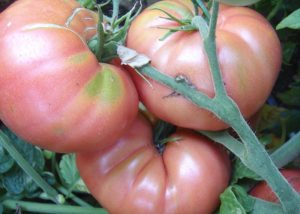 After the onset of the warm time, the plants are planted under film cover or in the greenhouse.
After the onset of the warm time, the plants are planted under film cover or in the greenhouse.
On ridges mark the holes with an interval of 40 cm in a row and 50 cm between the rows, they are brought in compost, ash, watered. Seedlings are planted in the hole, covered with earth and watered again, put support. The procedure for planting seedlings is best done in the afternoon.
Plant care is timely watering, dressing and weeding.
Fertilizers are carried out with a “from the barrel” fertilizer - with a mullein or grass extract diluted with water, and they are repeated depending on the state of the plants 1-2 times before the formation of ovaries. Then feed with potash and phosphate fertilizers and ashes. All types of dressings are preferably carried out after watering the plants
See also: Diseases of tomatoes in the greenhouse and their treatment
Tomatoes in greenhouses are exposed to pathogens due to high temperature and humidity. To avoid this, it is necessary to:
- Watering is carried out directly under the root of the plant.
- Mulch the soil.
- To air the greenhouse.
Grown up plants are tied up with supports, formed into 2-3 stems to produce larger fruits, stepson and cut off the lower leaves. With good conditions, large fruits can be obtained even with a large number of stems.
Video: Review of the variety of tomatoes "Pink Elephant"



